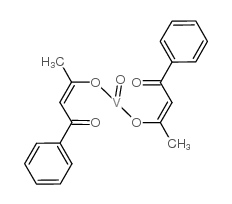14767-37-4
| Name | vanadium oxobis(1-phenyl-1,3-butanedionate) |
|---|---|
| Synonyms |
MFCD00013507
VANADYLPHENYLBUTANEDIONATE BIS(1-PHENYL-1,3-BUTANEDIONO)OXOVANADIUM(IV) VANADIUM IV OXIDE BIS(BENZOYLACETONATE) oxobis(1-phenylbutane-1,3-dionato-O,O')vanadium BIS(1-PHENYL-1 3-BUTANEDIONATO)OXOVANADIUM(IV) |
| Boiling Point | 262.2ºC at 760mmHg |
|---|---|
| Melting Point | 218ºC |
| Molecular Formula | C20H18O5V |
| Molecular Weight | 389.29500 |
| Flash Point | 96.9ºC |
| Exact Mass | 389.05900 |
| PSA | 69.67000 |
| LogP | 4.38920 |
| Appearance | solid |
| Vapour Pressure | 0.000184mmHg at 25°C |
Synonym:Bis(1-phenyl-1,3-butanedione)oxovanadium(IV Section 2 - COMPOSITION, INFORMATION ON INGREDIENTS
Risk Phrases: None Listed. Section 3 - HAZARDS IDENTIFICATION EMERGENCY OVERVIEW
Heat sensitive. Potential Health Effects Eye: Causes eye irritation. Skin: May cause skin irritation. May cause contact dermatitis. Ingestion: May cause digestive tract disturbances. Inhalation: Dust is irritating to the respiratory tract. Chronic: No information found. Section 4 - FIRST AID MEASURES Eyes: Flush eyes with plenty of water for at least 15 minutes, occasionally lifting the upper and lower eyelids. Get medical aid immediately. Skin: Get medical aid. Flush skin with plenty of water for at least 15 minutes while removing contaminated clothing and shoes. Remove contaminated clothing and shoes. Ingestion: If victim is conscious and alert, give 2-4 cupfuls of milk or water. Never give anything by mouth to an unconscious person. Get medical aid immediately. Inhalation: Get medical aid immediately. Remove from exposure and move to fresh air immediately. If not breathing, give artificial respiration. If breathing is difficult, give oxygen. Notes to Physician: Treat symptomatically and supportively. Antidote: None reported. Section 5 - FIRE FIGHTING MEASURES General Information: As in any fire, wear a self-contained breathing apparatus in pressure-demand, MSHA/NIOSH (approved or equivalent), and full protective gear. During a fire, irritating and highly toxic gases may be generated by thermal decomposition or combustion. Containers may explode when heated. Non-combustible, substance itself does not burn but may decompose upon heating to produce corrosive and/or toxic fumes. Extinguishing Media: Do NOT use straight streams of water. For small fires, use dry chemical, carbon dioxide, or water spray. For large fires, use water spray, fog or regular foam. Section 6 - ACCIDENTAL RELEASE MEASURES General Information: Use proper personal protective equipment as indicated in Section 8. Spills/Leaks: Absorb spill with inert material (e.g. vermiculite, sand or earth), then place in suitable container. Avoid runoff into storm sewers and ditches which lead to waterways. Clean up spills immediately, observing precautions in the Protective Equipment section. Avoid generating dusty conditions. Provide ventilation. Do not get water inside containers. Cover with plastic sheet to prevent spreading. Section 7 - HANDLING and STORAGE Handling: Wash thoroughly after handling. Remove contaminated clothing and wash before reuse. Use with adequate ventilation. Minimize dust generation and accumulation. Avoid contact with eyes, skin, and clothing. Keep container tightly closed. Avoid ingestion and inhalation. Storage: Keep container closed when not in use. Store in a cool, dry, well-ventilated area away from incompatible substances. Section 8 - EXPOSURE CONTROLS, PERSONAL PROTECTION Engineering Controls: Use process enclosure, local exhaust ventilation, or other engineering controls to control airborne levels. Exposure Limits CAS# 14767-37-4: Personal Protective Equipment Eyes: Wear appropriate protective eyeglasses or chemical safety goggles as described by OSHA's eye and face protection regulations in 29 CFR 1910.133 or European Standard EN166. Skin: Wear appropriate protective gloves to prevent skin exposure. Clothing: Wear appropriate protective clothing to prevent skin exposure. Respirators: Follow the OSHA respirator regulations found in 29 CFR 1910.134 or European Standard EN 149. Use a NIOSH/MSHA or European Standard EN 149 approved respirator if exposure limits are exceeded or if irritation or other symptoms are experienced. Section 9 - PHYSICAL AND CHEMICAL PROPERTIES Physical State: Crystals Color: shiny green Odor: odorless pH: Not available. Vapor Pressure: Negligible. Viscosity: Not available. Boiling Point: Not available. Freezing/Melting Point: 218 deg C Autoignition Temperature: Not available. Flash Point: Not available. Explosion Limits, lower: Not available. Explosion Limits, upper: Not available. Decomposition Temperature: Solubility in water: Negligible. Specific Gravity/Density: >1 Molecular Formula: C20H18O5V Molecular Weight: 389.29 Section 10 - STABILITY AND REACTIVITY Chemical Stability: Stable under normal temperatures and pressures. Conditions to Avoid: Incompatible materials, dust generation, strong oxidants. Incompatibilities with Other Materials: Strong oxidizing agents. Hazardous Decomposition Products: Carbon monoxide, irritating and toxic fumes and gases, carbon dioxide. Hazardous Polymerization: Will not occur. Section 11 - TOXICOLOGICAL INFORMATION RTECS#: CAS# 14767-37-4 unlisted. LD50/LC50: Not available. Carcinogenicity: Vanadium,oxobis(1-phenyl-1,3-butanedionato-o,o') - Not listed by ACGIH, IARC, or NTP. Section 12 - ECOLOGICAL INFORMATION Other No information available. Section 13 - DISPOSAL CONSIDERATIONS Dispose of in a manner consistent with federal, state, and local regulations. Section 14 - TRANSPORT INFORMATION IATA Shipping Name: VANADIUM COMPOUND, N.O.S. Hazard Class: 6.1 UN Number: 3285 Packing Group: II IMO Shipping Name: VANADIUM COMPOUND, N.O.S. Hazard Class: 6.1 UN Number: 3285 Packing Group: II RID/ADR Shipping Name: VANADIUM COMPOUND, N.O.S. Hazard Class: 6.1 UN Number: 3285 Packing group: II Section 15 - REGULATORY INFORMATION European/International Regulations European Labeling in Accordance with EC Directives Hazard Symbols: Not available. Risk Phrases: Safety Phrases: S 24/25 Avoid contact with skin and eyes. WGK (Water Danger/Protection) CAS# 14767-37-4: No information available. Canada CAS# 14767-37-4 is listed on Canada's NDSL List. CAS# 14767-37-4 is not listed on Canada's Ingredient Disclosure List. US FEDERAL TSCA CAS# 14767-37-4 is listed on the TSCA inventory. SECTION 16 - ADDITIONAL INFORMATION N/A |
| Risk Phrases | 22-36/37/38 |
|---|---|
| Safety Phrases | 24/25 |
